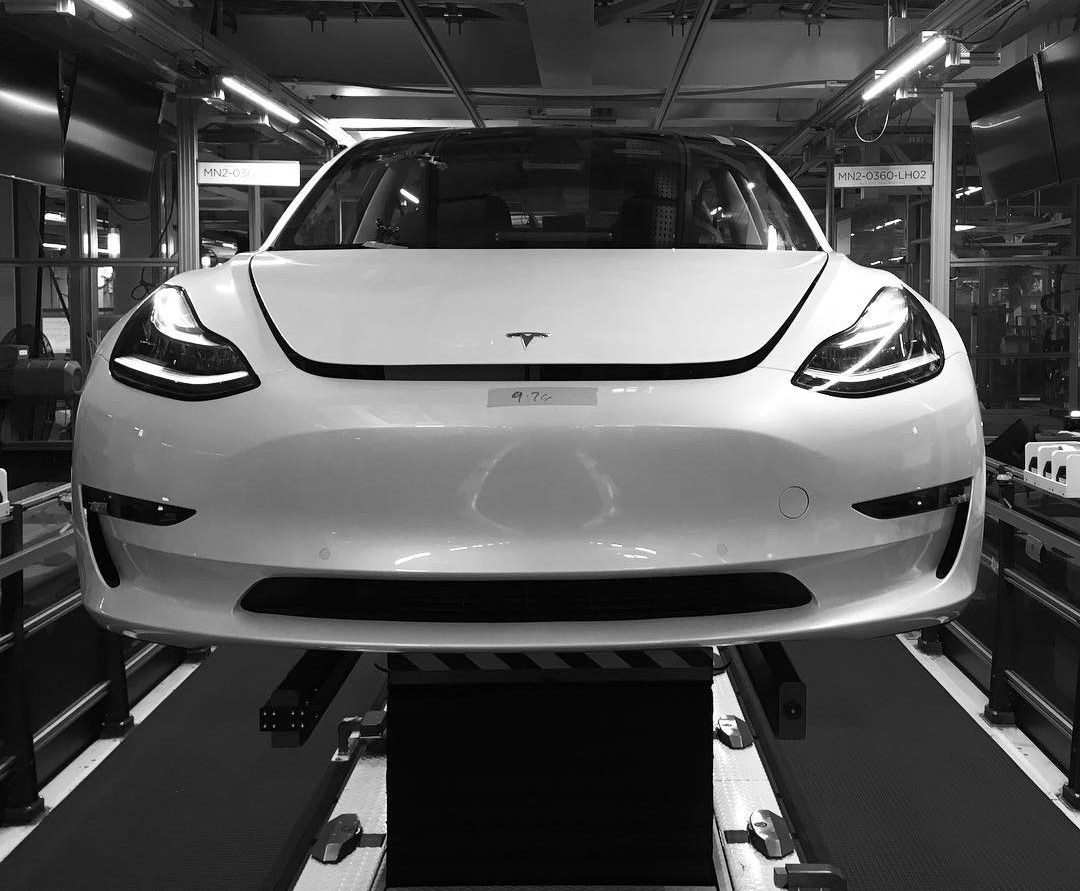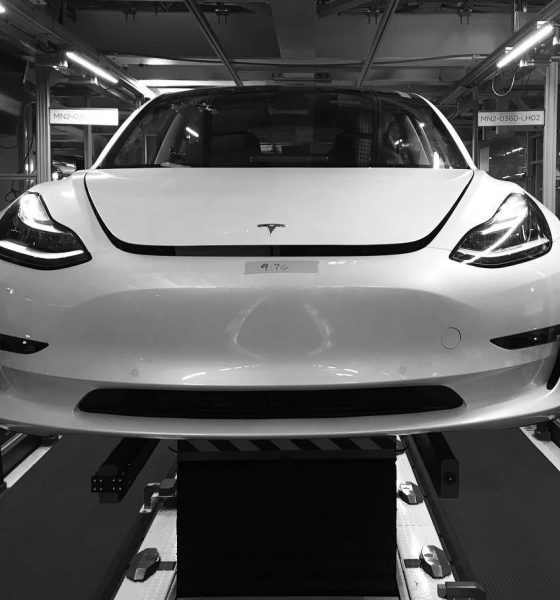

Investor's Corner
Tesla explains oversight on Model 3 production line automation
Following consistent delays in Model 3 production, Tesla is attempting to fine-tune their automation strategy to solve production bottlenecks. As noted in Tesla’s Q1 Earnings Report, the company is currently producing 2,270 Model 3’s per week, less than half of the 5,000/week goal they set for the end of June.
Even after Tesla CEO Elon Musk stated that humans were “underrated” and that “excessive automation at Tesla was a mistake,” Tesla is largely crediting quality improvements to their highly-automated production.
“We are already seeing many benefits from heavily increasing automation as part of the Model 3 production process. Through the vast majority of Model 3 production, including in body welding, general assembly, inverter and drive unit production, our automation effort has been very successful. Based on every measurable metric, Model 3 is already the highest quality vehicle we have ever produced, and this is unquestionably due in large part to automation,” Tesla stated in their Q1 Update Letter.
Despite early success with a large amount of the Model 3’s automated production line, Tesla is dialing back some of the processes. The company stated, “In those select areas where we have had challenges ramping fully automated processes, such as portions of the battery module line, part of the material flow system, and two steps of general assembly, we have temporarily dialed back automation and introduced certain semi-automated or manual processes while we work to eventually have full automation take back over.”
"Vast majority of production system is automated… but we went too far and automated some pretty silly things" Silliest item? "Basically placement 'fluff' on the top of the battery pack was automated with a 'fluff machine'" Super complex, used a vision system $TSLA @Teslarati
— Christian Prenzler (@clprenz) May 2, 2018
7 Hours to make a pack 3 weeks ago, now is 17 minutes – @elonmusk
We are slightly ahead in battery cell and module production, general assembly area is the source of some production delays. $TSLA @Teslarati— Christian Prenzler (@clprenz) May 2, 2018
Model 3 Simplified by Design
Tesla isn’t only banking on automated processes to ramp up production of the Model 3. The company also highlighted that the vehicle was designed to be easily mass-produced. Tesla stated that the vehicle’s assembly line consists of 70% less steps compared to traditional assembly lines.
The Model 3’s assembly line has 50 different steps and the vehicle is built on a singular body frame. By comparison, the Model S has over 80 different body frames. Tesla also cited that the vehicle has lighter wiring and fewer controllers, connectors, and CPUs compared to ‘average vehicles’.
As a result of the Model 3’s simplified design and highly-automated production line, Tesla expects the vehicle to carry a 25% gross margin, much higher than its peers.
“All these elements are rooted in design and critical not only to our ability to reach higher levels of output in a smaller amount of factory space but also to achieve lower levels of
cost,” Tesla stated.
It’s expected that Tesla will optimize the level of automation on the Model 3 line following a planned 10-day shutdown in production in the second quarter. With more people involved in vehicle production, Tesla can dynamically adjust overtime hours and staffing levels to meet line goals.

Investor's Corner
Tesla stock closes at all-time high on heels of Robotaxi progress

Tesla stock (NASDAQ: TSLA) closed at an all-time high on Tuesday, jumping over 3 percent during the day and finishing at $489.88.
The price beats the previous record close, which was $479.86.
Shares have had a crazy year, dipping more than 40 percent from the start of the year. The stock then started to recover once again around late April, when its price started to climb back up from the low $200 level.
This week, Tesla started to climb toward its highest levels ever, as it was revealed on Sunday that the company was testing driverless Robotaxis in Austin. The spike in value pushed the company’s valuation to $1.63 trillion.
Tesla Robotaxi goes driverless as Musk confirms Safety Monitor removal testing
It is the seventh-most valuable company on the market currently, trailing Nvidia, Apple, Alphabet (Google), Microsoft, Amazon, and Meta.
Shares closed up $14.57 today, up over 3 percent.
The stock has gone through a lot this year, as previously mentioned. Shares tumbled in Q1 due to CEO Elon Musk’s involvement with the Department of Government Efficiency (DOGE), which pulled his attention away from his companies and left a major overhang on their valuations.
However, things started to rebound halfway through the year, and as the government started to phase out the $7,500 tax credit, demand spiked as consumers tried to take advantage of it.
Q3 deliveries were the highest in company history, and Tesla responded to the loss of the tax credit with the launch of the Model 3 and Model Y Standard.
Additionally, analysts have announced high expectations this week for the company on Wall Street as Robotaxi continues to be the focus. With autonomy within Tesla’s sights, things are moving in the direction of Robotaxi being a major catalyst for growth on the Street in the coming year.
Elon Musk
Tesla needs to come through on this one Robotaxi metric, analyst says
“We think the key focus from here will be how fast Tesla can scale driverless operations (including if Tesla’s approach to software/hardware allows it to scale significantly faster than competitors, as the company has argued), and on profitability.”

Tesla needs to come through on this one Robotaxi metric, Mark Delaney of Goldman Sachs says.
Tesla is in the process of rolling out its Robotaxi platform to areas outside of Austin and the California Bay Area. It has plans to launch in five additional cities, including Houston, Dallas, Miami, Las Vegas, and Phoenix.
However, the company’s expansion is not what the focus needs to be, according to Delaney. It’s the speed of deployment.
The analyst said:
“We think the key focus from here will be how fast Tesla can scale driverless operations (including if Tesla’s approach to software/hardware allows it to scale significantly faster than competitors, as the company has argued), and on profitability.”
Profitability will come as the Robotaxi fleet expands. Making that money will be dependent on when Tesla can initiate rides in more areas, giving more customers access to the program.
There are some additional things that the company needs to make happen ahead of the major Robotaxi expansion, one of those things is launching driverless rides in Austin, the first city in which it launched the program.
This week, Tesla started testing driverless Robotaxi rides in Austin, as two different Model Y units were spotted with no occupants, a huge step in the company’s plans for the ride-sharing platform.
Tesla Robotaxi goes driverless as Musk confirms Safety Monitor removal testing
CEO Elon Musk has been hoping to remove Safety Monitors from Robotaxis in Austin for several months, first mentioning the plan to have them out by the end of 2025 in September. He confirmed on Sunday that Tesla had officially removed vehicle occupants and started testing truly unsupervised rides.
Although Safety Monitors in Austin have been sitting in the passenger’s seat, they have still had the ability to override things in case of an emergency. After all, the ultimate goal was safety and avoiding any accidents or injuries.
Goldman Sachs reiterated its ‘Neutral’ rating and its $400 price target. Delaney said, “Tesla is making progress with its autonomous technology,” and recent developments make it evident that this is true.
Investor's Corner
Tesla gets bold Robotaxi prediction from Wall Street firm
Last week, Andrew Percoco took over Tesla analysis for Morgan Stanley from Adam Jonas, who covered the stock for years. Percoco seems to be less optimistic and bullish on Tesla shares, while still being fair and balanced in his analysis.

Tesla (NASDAQ: TSLA) received a bold Robotaxi prediction from Morgan Stanley, which anticipates a dramatic increase in the size of the company’s autonomous ride-hailing suite in the coming years.
Last week, Andrew Percoco took over Tesla analysis for Morgan Stanley from Adam Jonas, who covered the stock for years. Percoco seems to be less optimistic and bullish on Tesla shares, while still being fair and balanced in his analysis.
Percoco dug into the Robotaxi fleet and its expansion in the coming years in his latest note, released on Tuesday. The firm expects Tesla to increase the Robotaxi fleet size to 1,000 vehicles in 2026. However, that’s small-scale compared to what they expect from Tesla in a decade.
Tesla expands Robotaxi app access once again, this time on a global scale
By 2035, Morgan Stanley believes there will be one million Robotaxis on the road across multiple cities, a major jump and a considerable fleet size. We assume this means the fleet of vehicles Tesla will operate internally, and not including passenger-owned vehicles that could be added through software updates.
He also listed three specific catalysts that investors should pay attention to, as these will represent the company being on track to achieve its Robotaxi dreams:
- Opening Robotaxi to the public without a Safety Monitor. Timing is unclear, but it appears that Tesla is getting closer by the day.
- Improvement in safety metrics without the Safety Monitor. Tesla’s ability to improve its safety metrics as it scales miles driven without the Safety Monitor is imperative as it looks to scale in new states and cities in 2026.
- Cybercab start of production, targeted for April 2026. Tesla’s Cybercab is a purpose-built vehicle (no steering wheel or pedals, only two seats) that is expected to be produced through its state-of-the-art unboxed manufacturing process, offering further cost reductions and thus accelerating adoption over time.
Robotaxi stands to be one of Tesla’s most significant revenue contributors, especially as the company plans to continue expanding its ride-hailing service across the world in the coming years.
Its current deployment strategy is controlled and conservative to avoid any drastic and potentially program-ruining incidents.
So far, the program, which is active in Austin and the California Bay Area, has been widely successful.








